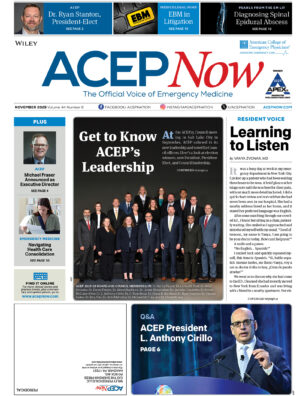A 90-day-old baby was transported to my emergency department recently. A poorly worded note with a brief medical history and list of medicines accompanied the frail little guy.
Explore This Issue
ACEP News: Vol 28 – No 01 – January 2009Of course, the patient couldn’t tell us his problem; he only occasionally would let out a feeble cry. We tried for hours to reach his family and his physician, but nobody responded. After conducting exhaustive testing, I could find nothing wrong with this lovable creature of God. We couldn’t just send him back, so we were forced to admit him.
Now, read those paragraphs again and substitute “90-year-old man.”
If a baby had been truly dropped on our doorstep and no one had come to claim him, it would have been big news. The event might have made the front page of the newspaper or been the lead story on the evening news broadcast. Even the most cold-hearted person in the hospital (I’ll leave it to you to decide who that might be) would have been outraged at the lack of responsibility and the catastrophic moral failure of his caregivers.
Fortunately, babies on the doorstep are an infrequent occurrence. Why is it that oldies on the doorstep are a daily occurrence in most emergency departments?
Elderly people who can help themselves no better than an infant are sent from home or the extended care facility (ECF), and no one comes with them. Little useful information is communicated about the reason for their visits, and emergency physicians and nurses are left in the situation in which a veterinarian often finds herself. It’s probably worse, though—people usually accompany their dogs or cats to the animal hospital.
I’ll go out on a limb and predict that if at the same time a demented octogenarian and a golden retriever were left unattended at the door of my department, more sympathy would be generated for the dog. The reporters would trip over the feet of the man to get a good picture of the canine.
It’s clear that as a society we place a higher standard on the care of infants (and possibly dogs) than the care of the frailest of our oldest citizens.
It’s not because one is more helpless than the other. It’s not because one life is intrinsically more valuable than another. What do these infants have that most of the elderly folks don’t have?
A mom.
Mothers will risk their lives to protect their children. Even the most marginal mother does not send her infant to an emergency department alone. There is something about the love a mother has for her children that transcends other human relationships. Unfortunately, as the years pass this important relationship, for varied reasons, is not necessarily reciprocated. While most people are devoted to their parents, many dependent elderly have an acute advocate deficiency.
One might expect that nursing homes would fill this role of advocate, but it seems they just go through the motions. Usually they can’t convey even the most basic information appropriately. I swear that every ECF employee in the country went to the same class on how to run a copy machine. It is uncanny that no matter which facility sends the patient, the first four letters of the names of medications is cut off on the paperwork. It makes you want to reach through the fax machine and do something that would jeopardize your medical license.
I find it interesting that nursing homes rarely send anyone with their patients, but the group homes that send patients to my ED always do this. While the attendants may not know many specifics about the group home resident, they always come with a book that contains just about everything you would want to know. The attendants also seem genuinely concerned about the residents in their charge. Why is it that the nursing homes can’t do this?
So, we are increasingly placed in the position of being doctor to patients with poorly communicated but complex medical problems, as well as being mother to these folks who seem to have no real advocate. This is bad, because the list of uncompensated tasks we are asked to do grows while society at large becomes more dependent on people and agencies outside their immediate family. And the safety net continues to stretch.
The other side is that this is a good thing, because as emergency physicians we are experts in the quick evaluation of complicated patients—and we are fantastic advocates for the underdogs of society. These are the people Dr. Jack McConnell refers to as those whom society renders invisible. We see them just fine.
We go to battle every day to be sure that the “undesirable” patients find a way into the hospital. We cajole consultants and prod social workers to do the right thing, because we know that if we don’t do this, no one else will.
As the demographics shift and we care for more elderly patients, our role as advocate will become more important. We will need to take special care to identify those who have no voice, and act to be sure their interests and their desires are shepherded. This can be more difficult than it seems in a busy department.
From now on, when I see an elderly person alone on a stretcher, I’m going to remember that he or she used to be a baby. If I frame it that way, I hope I’ll act as the patient’s mother would want me to.
Dr. Baehren lives in Ottawa Hills, Ohio. He practices emergency medicine and is an assistant professor at the University of Toledo Medical Center. Your feedback is welcomed at David.Baehren@utoledo.edu.
Pages: 1 2 3 | Multi-Page


No Responses to “Everybody Needs a Mom”